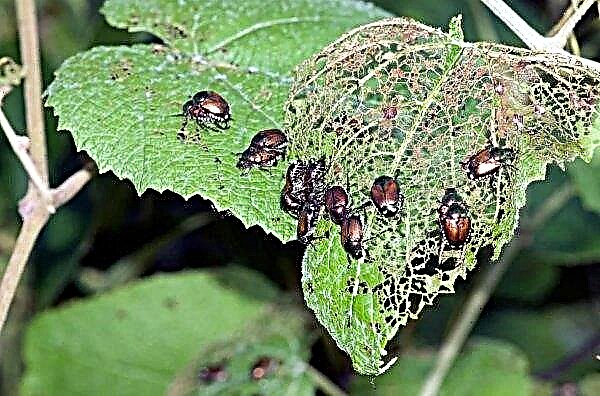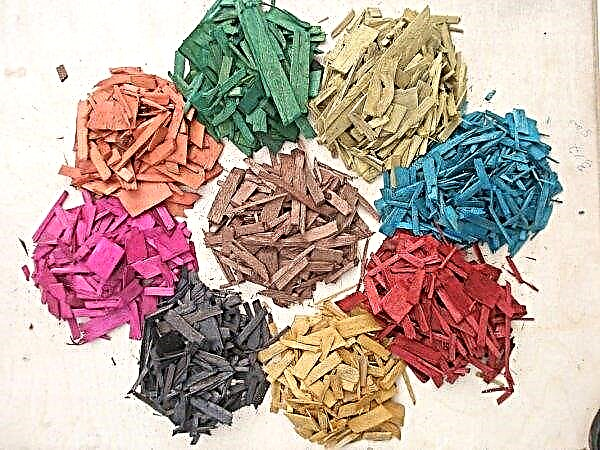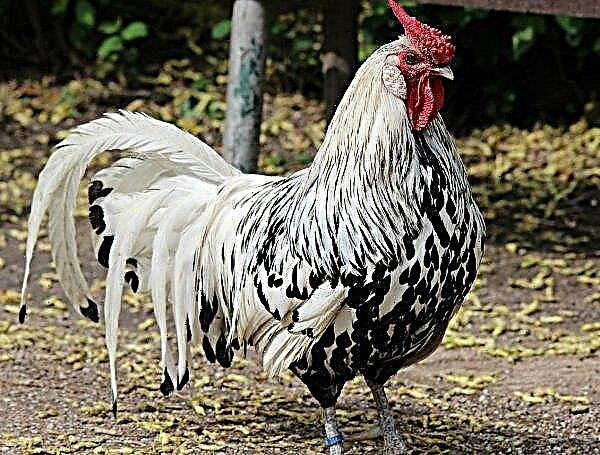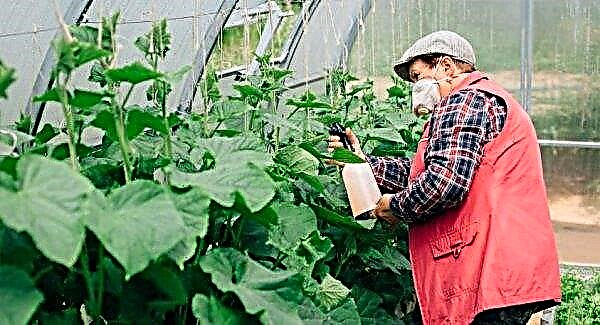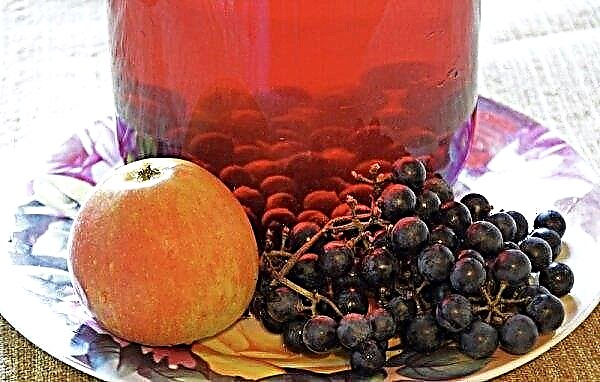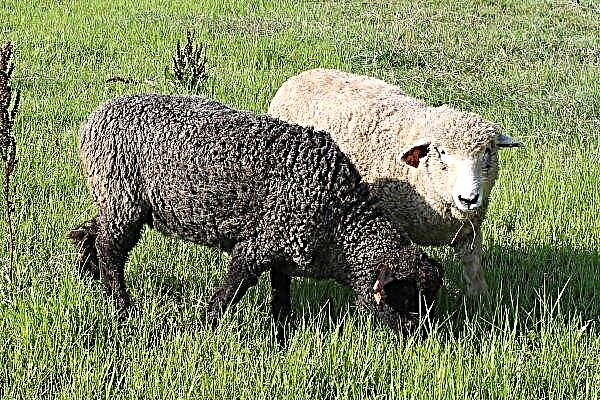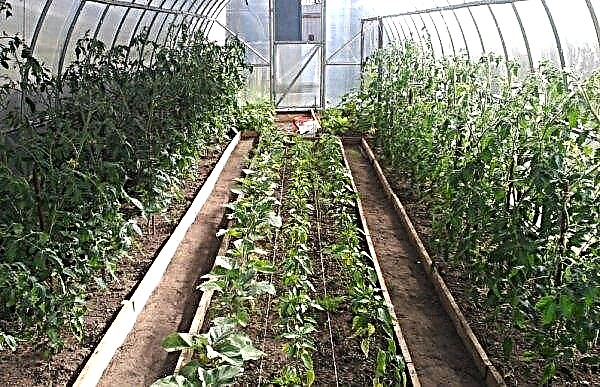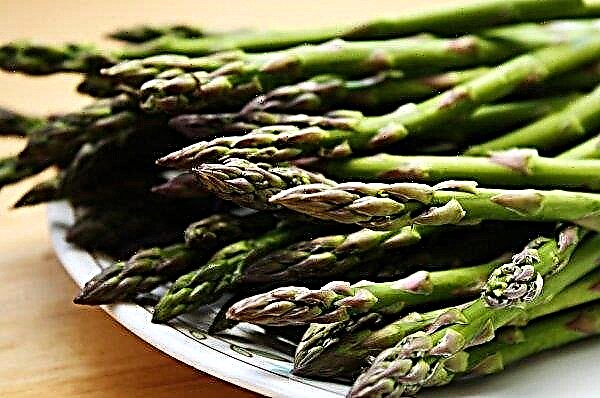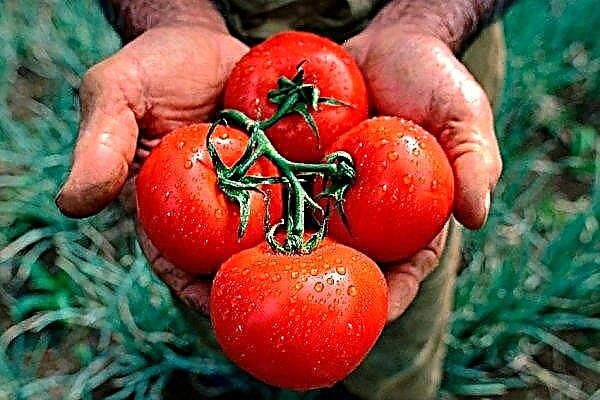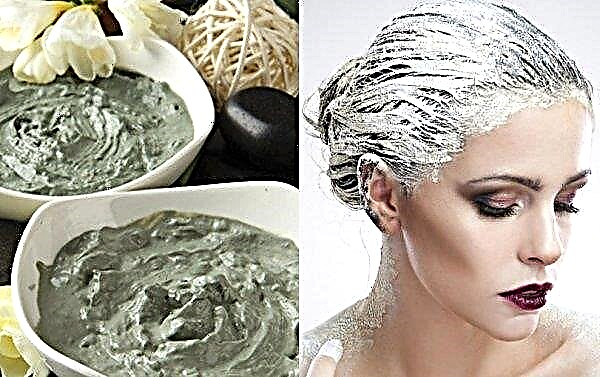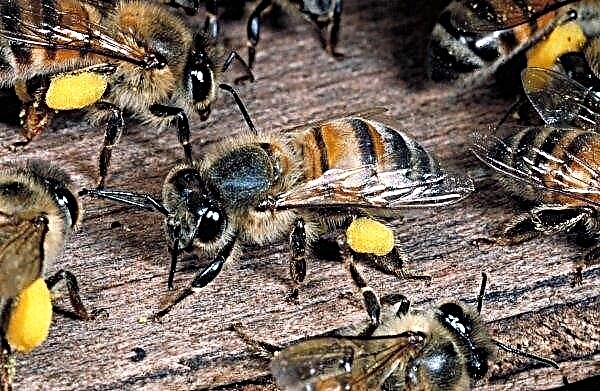The horizontal, or creeping juniper reaches a height of 30 cm and spreads several meters wide. It is used as a groundcover when creating alpine slides or Japanese-style gardens. You can learn more about the representative of horizontal varieties - Wiltoni, and the features of caring for him from this article.
Botanical Description
The appearance of creeping juniper (Juniperus horizontalis) is very unusual and attractive. This undersized shrub grows ubiquitously in North America, over much of Canada.
Its height does not exceed 30 cm. Slender shoots reach a length of 1.2 m. The leaves are arranged in opposite pairs, sometimes in whorls of 3 pcs. Adult leaflets are scaly, 1–2 mm long and 1–1.5 mm wide. The juvenile foliage of young plants is acicular, 5–10 mm long. Cones are berry-like. They are bisexual, dark blue with a pale blue-white waxy coating, spherical in shape, 5–7 mm in diameter. In each of them 2 seeds. Male cones are small, up to 4 mm. They appear in early spring.
Creeping juniper can create hybrids with virgin (Juniperus virginiana), which is interesting to gardeners who practice the cultivation of unusual forms of plants. Its hybrids with rock juniper (Juniperus scopulorum) are also found. At the moment, more than 100 varieties of this species have been obtained.
Viltoni is a natural mutation discovered by Jacob van Hainingen in 1914 on Vinalhaven Island, Maine.. It is a compact flat "rug" with hanging branches and attractive gray-blue needles. After 10 years of growth, Viltoni will reach a width of 3 m, but will not exceed a couple of tens of centimeters in height.
Did you know? Viltoni fruits are used as a spice for baking bread and muffin.
Botanical grade description:
- name: Juniperus Horizontalis Wiltonii;
- type: evergreen;
- growth habits: creeping, carpet-like, fast-growing;
- annual growth of shoots: 15–20 cm;
- family: Cypress (Cupressaceae);
- winter hardiness zone: 3–9 (withstands minimum temperatures up to –40 ° С);
- height: 20–25 cm;
- width: 3 m;
- shoots: weaving;
- length of one shoot: up to 1.2 m;
- bark: taupe;
- needles: bluish-silver in summer, in winter a deeper bluish color;
- needles: small, not more than 0.5 cm, located very tightly to each other, fragrant;
- cones: blue with a wax coating, 0.5 cm in diameter;
- Lighting: sunny area;
- irrigation: moderate;
- proposed use: as a groundcover;
- well tolerates: dry soil, rocky soils, polluted air;
- life expectancy: up to 50 years.

Landing
Creeping juniper is planted in a sunny area. Here it is necessary to take into account the fact that blue varieties in the shade lose their color and become simply green with a grayish tint. To prevent this, a solar zone is required. The plant is tolerant to most soils, including heavy and slightly alkaline. They begin landing in late spring. Creeping varieties can be planted in open ground and in containers.
For landing you will need:
- substrate for conifers from the store or prepared soil mixture;
- organic fertilizers - humus, peat or compost;
- drainage - pebbles.
Did you know? Juniper is a salt tolerant plant. It can be planted in coastal areas where other plants may not be accepted. In addition, creeping varieties are convenient to strengthen the slopes of hilly areas.
Seedling preparation
Usually nurseries sell seedlings of two to three years of age. They will transfer the transplant less painfully. At home, remove the plant from the container and soak its roots in a solution of water with a stimulator for root growth. Dilute the drug according to the instructions. So, for example, "Kornevin" is bred in a proportion of 5 g / 5 l of water. Soaking time - 12-24 hours. When the plant is planted in the ground, the water in which it was soaked can be poured into the planting pit.

Site selection and preparation
Given that the bush grows to 3 m in diameter, when planting several, observe a distance between them of at least 1 m. The landing area is dug up. Stones and weeds are removed at the same time. If you prefer to cut the lawn with a mower, then you must definitely level the site. The ground cover juniper can also be cut, but then the bumps in the soil will be invisible, and this can damage the mower or plant.
Important! Gardeners recommend that when transplanting, they treat the roots with a growth stimulator, and then dip them into the clay mash with the addition of copper sulfate to prevent infection of the plant with fungal diseases.
Soil acidity is also important for Viltoni. Although junipers tolerate neutral or slightly alkaline soil, they prefer acidic soil: they develop better on it. The correct acidity range for them is from 5.5 to 7 on the pH scale. It is important that most garden soils are in this range - from 6 to 7 on the pH scale.
In the process of development, any plants consume nutrients from the soil, which makes it acidic. For this reason, there is no need to check the acidity level. If the plot grew plants, then it is acidic. Adding organic compost to the soil or using compost as mulch will increase acidity.

Landing process
If you want the juniper to be more magnificent, you will need to fertilize the soil. After the landing pit is dug, the seized soil is mixed with turf soil, peat, needles and sand in equal proportions.
Step-by-step landing instructions:
- The depth of the landing pit should be 2 times greater than the root coma.
- The bottom layer is drainage, the thickness of which is 20 cm.
- The next layer is the soil substrate.
- On top of it is a seedling.
- Water poured into the pit, in which the juniper roots were soaked, and the soil was added.
- Make sure that the root neck is at the same level as the seedling grew in the nursery.

When transplanting to a permanent place, it is important to ensure that the soil is constantly moist, at least during the first weeks, while the seedling is rooted. After this, it should be watered only if the soil has visually dried out. It is not necessary to fertilize the planted bush during the first year of growth. Firstly, the fertilizers applied during planting are enough. And secondly, it is able to grow on depleted soil.
Juniper Care
Juniper requires minimal maintenance after planting. Ground cover varieties grow very quickly, so they have to be trimmed periodically. Among other mandatory activities - watering and fertilizing. Pests rarely pose a problem for the species in question, with the exception of spider mites. For this reason, gardeners occasionally treat Viltoni with insecticides.
Stamping
A stem is a form of plant in which a tree is formed from a bush, practicing pruning of side shoots. To get a magnificent crown, the ends of the branches of such a bush are cut to the first bud, which stimulates branching. The result is one shoot on which the round crown is located. Wiltoni is a groundcover culture. Its height rarely exceeds 20 cm, and shoots are woven on the ground. Accordingly, it is impossible to create a standard from such a plant.
Watering
An adult plant is provided with moisture using normal rainfall. But from additional watering the bushes grow better. It is important to water them well in the first weeks after planting, then in October, and if dry weather without precipitation sets in. For undersized shrubs, an ideal solution would be to organize drip irrigation.

- Among its advantages:
- slow soil wetting;
- moisture does not get on the leaves and does not create conditions for the development of phytopathogens;
- reduction in total water consumption;
- ensuring uniformity of soil wetting.
To improve rooting and help the juniper endure stress after planting, it is watered with the addition of growth stimulants.
Important! The use of fresh manure or bird droppings to fertilize plants is unacceptable. They have too many active substances that can burn the roots.
Among them:
- “Heteroauxin” - growth hormone with the function of accelerating the development of the root system;
- "Succinic acid" - a broad spectrum stimulant.
When using a stimulant, always follow the instructions for the drug.
Top dressing
Ground cover varieties are not active consumers of fertilizers, so it is enough to feed them once a year - in early spring. You can purchase any of the fertilizers for conifers - they are distinguished by a low nitrogen content. This element is necessary for the active growth of foliage and shoots. The coniferous Viltoni has no leaves, and he does not need so much nitrogen. But he needs magnesium, which is not in fertilizers for deciduous crops. Among the most popular fertilizers: “Green Needle”, “Needle”, “Aquarin”, “Fertika-Lux” and other mixtures. You need to make them according to the instructions on the packaging.

The Green Needle is especially convenient. It contains a large percentage of magnesium and sulfur. They are needed in order to maintain the blue color of Wiltoni. In addition, these substances prevent yellowing of needles in the winter from a lack of moisture. Nitrogen in the composition of only 3.4%, which is also optimal for conifers.
Loosening and mulching
Loosening is necessary to ensure access of air to the soil. Roots without access to oxygen in dense soil can get root rot, and the plant begins to wither. In addition, loosening destroys the roots of weeds and inhibits their growth. Oxygen is also needed to ensure the functioning of beneficial soil microorganisms.
Important! Be sure to loosen when you clean in the flower garden after winter. At this moment, the fallen needles and garbage are removed, and the soil under the juniper shoots is loosened to a depth of 5–7 cm
However, Viltoni is a ground cover, which makes loosening problematic. For this reason, gardeners mulch the land on which the bush is located. Mulch can be chopped straw, needles and other materials. It will prevent weed growth, soil compaction, and excessive moisture evaporation.
As the mulch decomposes, the vital nutrients that the plant needs will enter the soil. But do not use freshly chopped wood or fresh compost for this. Any organic substances must be aged for at least 6 months before they are used.

Pruning
Juniper refers to crops that poorly perceive pruning, therefore minimizing it. In the spring, the bushes begin a new growth, in the summer it is insignificant, but in the autumn another wave can go. Juniper needles are renewed once every couple of years, so at the end of winter, after the snow has melted and the temperature rises to 0 ° C, Viltoni bushes are cleaned of fallen needles and dried branches.

You don’t need to cut anything else. An exception is the situation when the size of the site is limited. Then the shoots are trimmed so that they do not go beyond the boundaries of the site.
Winter preparations
Juniper tolerates winter well. It does not freeze, but there are a number of other problems that need to be solved:
- In October, before frosts, the plant should be abundantly watered. Conifers do not stay idle in winter, unlike deciduous crops, so they need water so that the needles do not dry out.
- Under shoots on the soil, a layer of fresh mulch must be laid. The old and summer ones are harvested, since insect pests can be placed in it for the winter. Mulch will prevent temperature fluctuations in the soil and root damage due to them.
- If the winter is snowless, then the juniper surface is covered with spruce branches. It will protect plants from frost.

Possible diseases and pests
Juniper does not have many diseases. If you find that the needles turn yellow, then most likely it is a fungal infection. Immediately carefully trim the damaged parts of the plant. This is done with a sterile instrument, the cutting edges of which are rubbed with alcohol. And then spraying is carried out with any copper-based fungicide - for example, 0.5% copper sulfate or 1% Bordeaux liquid.
Important! Ticks develop resistance to any drugs, therefore, when re-infected, you need to buy another drug and spray it with it already.
The main pests:
- Aphids - small brown insects that settle in colonies on young shoots. To combat use spraying with a solution of insecticidal soap (15 g / 1 l of water), repeating after 10 days.

- Spider mites - very small, up to 1 mm, reddish insects. They settle in secluded places, and at night eat the juice of young leaves and shoots. Anti-ticks are sprayed with Actellic or Fitoverm. After 10 days, the treatment is repeated.
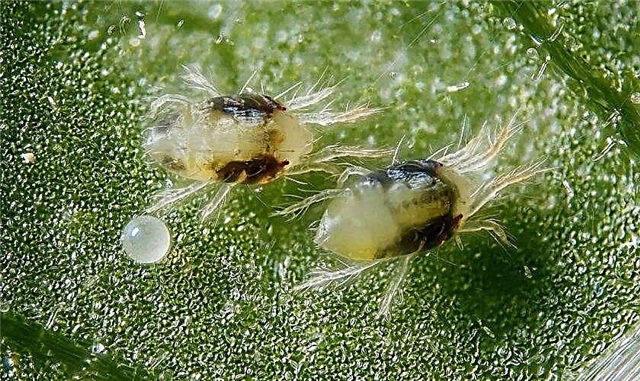
Breeding methods
Creeping juniper can be grown from both cuttings and seeds.. The first method is considered faster and more convenient for gardeners. As a result, you get a plant that is completely identical to the desired one.
As for seed propagation, it is more used by breeders to breed new varieties. Seed propagation for a private compound has a number of features that should be remembered. Normally, juniper branches are green. All other varieties - blue, silver, golden - are hybrids. Their seeds do not inherit the characteristics of parent plants, therefore it is better to propagate juniper with cuttings.
Step-by-step instructions for propagation by cuttings:
- At the end of August, choose a healthy shoot, cut it off. Separate into pieces of 15 cm. Remove the leaves from the bottom of the handle.
- Next, prepare a pot and nutrient substrate. This can be a substrate from the store for coniferous crops or a mixture of peat, sod land, vermiculite and quartz sand in equal quantities.
- The end of the handle is dipped in “Kornevin” or another growth hormone.
- The soil is disinfected with a pale pink solution of potassium permanganate.
- Make a hole with a pencil and plant a stalk in it. Watered.
- After that, cover the material with a film, but so that it rests on supports - for example, on sticks, and not on the handle itself.
- Set the container in a room with a temperature of +20 ... 21 ° C for rooting.
- From time to time, check the humidity and irrigate the soil with settled water from a watering can. The rooting duration is about 1-2 months.
- Then the film is removed, and the seedling is grown indoors until the spring of next year, when it can be planted in the ground at a constant place.

Use in landscape design
Low ground cover varieties are used to design slopes. They ennoble such a site, and there we will not need to mow the weeds. Some people prefer to plant such varieties in places where it is difficult to water and care for plants.
Did you know? The oldest juniper bush grows in the Crimea. Botanists believe that he is already 2,000 years old.
Ground covers also look good in rock gardens, as they do not have special soil requirements. They are good and next to rose bushes. Juniper in this case not only fills the empty space, but can also become part of the flower arrangement if combined with phlox, heather and other plants.

The Viltoni variety is unpretentious: it is perfectly adapted to any climatic conditions, can be grown both in open ground and in containers, which makes it popular among gardeners. Caring for it will also not be difficult if you adhere to simple and understandable rules.



